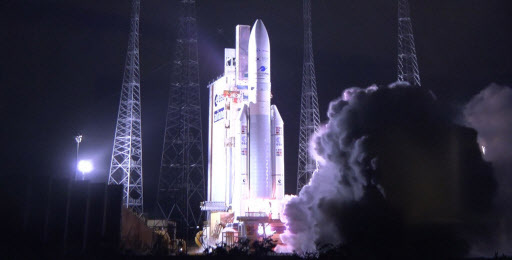Korean-made geostationary environment-monitoring satellite successfully launched
By YonhapPublished : Feb. 19, 2020 - 09:18

The world's first geostationary environment-monitoring satellite built by South Korea has been successfully launched, the country's state-run aerospace research institute said Wednesday.
The Ariane-5 rocket carrying the 3.4-ton Chollian-2B, tasked with monitoring the movement of fine dust and other air pollutants in the East Asian region, as well as tides, is on course to reach its transfer orbit some 36,000 kilometers above the Earth's equator after lifting off from French Guiana at 07:18 p.m. (local time), according to the Korea Aerospace Research Institute.
The satellite was separated from the rocket 31 minutes after lift-off and made the first contract with a ground tracking station in Australia.
The Chollian-2B is expected to begin carrying out given missions in October, with all systems to be fully operational in 2021.
The multipurpose satellite will observe and track fine dust and 20 types of air pollutants, including ozone, sulfur dioxide and formaldehyde, KARI said.
The satellite will allow South Korea to keep close tabs on all sorts of pollutants in the region and play an important role in global air monitoring. The information gathered will make it possible to provide more accurate weather forecasts and permit Seoul to work with others to reduce pollution in the region.
The satellite is equipped with the cutting-edge Geostationary Ocean Color Imager-2 (GOCI-2), which can check for algal blooms and other water contaminants.
GOCI-2 is able to cover an area around 2,500 kilometers in diameter 10 times a day. The optical resolution used on the Chollian-2B is four times sharper than previous sensors used by South Korea, making it that much easier to detect red and green tides, and improving the possibility of giving advance warnings to regions that may be affected.
The space agency said the latest launch follows the successful deployment of the Chollian-2A satellite in late 2018 and gives South Korea the world-class capability to monitor the atmosphere and oceans.
South Korea has spent 386.7 billion won ($324 million) for the Chollian-2B project, which began in 2011. The life cycle of the satellite is 10 years, the same as the Chollian-2A, it added. (Yonhap)










![[Today’s K-pop] BTS pop-up event to come to Seoul](http://res.heraldm.com/phpwas/restmb_idxmake.php?idx=644&simg=/content/image/2024/04/17/20240417050734_0.jpg&u=)
![[Graphic News] More Koreans say they plan long-distance trips this year](http://res.heraldm.com/phpwas/restmb_idxmake.php?idx=644&simg=/content/image/2024/04/17/20240417050828_0.gif&u=)






![[KH Explains] Hyundai's full hybrid edge to pay off amid slow transition to pure EVs](http://res.heraldm.com/phpwas/restmb_idxmake.php?idx=652&simg=/content/image/2024/04/18/20240418050645_0.jpg&u=20240419100350)

